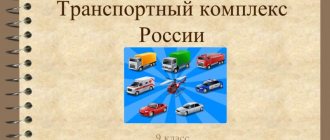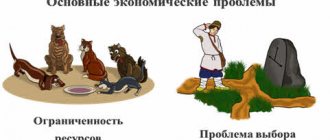Test on the topic “Secondary sector of the economy.” Option 2
Test on the topic “Secondary sector of the economy.”
Option 2
I. Run the test:
1. Which branch of mechanical engineering is located in areas with developed metallurgy?
a) instrument engineering c) electronic engineering b) heavy engineering d) all the named industries 2. Which branches of mechanical engineering should develop at a faster pace in the era of scientific and technological revolution? a) heavy engineering c) transport engineering b) precision engineering d) agricultural engineering 3. The factor of decisive importance for the location of oil refining industry enterprises is: a) raw materials c) transport b) water d) labor 4. Where are the large gas fields in Russia? a) in Western Siberia c) in the Kursk region b) in Kuzbass d) in Central Russia 5. Which power plants in Russia generate the bulk of electricity? a) Thermal power plant b) Hydroelectric power station c) Nuclear power plant 6. What factor(s) is(are) of great importance for the location of enterprises producing heavy non-ferrous metals? a) raw materials c) transport b) labor d) all of the above factors 7. Which factor(s) is important for the location of the pulp and paper industry? a) electric power c) transport b) water d) all the above factors 8. What type of transport is used throughout the country? a) road c) air b) railway d) sea 9. Which factor(s) is(are) of great importance for the location of light industry enterprises? a) raw materials c) electric power b) consumer d) all mentioned factors
II. Give definitions to the following concepts: cooperation, full-cycle ferrous metallurgy enterprise, forestry complex.
III. Answer the questions:
1. What industries make up the secondary sector of the economy? 2. Compile a comprehensive description of the fuel and energy complex of Central Russia. 3. What is the composition of the mechanical engineering industries in Russia? 4. What are the factors for locating non-ferrous metallurgy enterprises? 5. List the major centers of the chemical industry in Russia. 6. What are the problems and prospects for the development of the Russian food industry?
multiurok.ru
Test with answers on the topic of sectoral structure of the economy
Do you agree with the statement?
1 An economic sector is a set of enterprises producing products similar in purpose or providing similar services? Yes
2 economies of any country are the totality of natural and human-created wealth that are used to ensure life and improve the living conditions of the country's population? Yes
3 The sectoral structure of the economy is the totality of all sectors of the country’s economy? Yes
4 does the tertiary sector include industries that directly use or extract natural resources? No
5 the secondary sector consists of industries that process natural resources? Yes
6 The primary sector unites industries through goods and services? No
7 does the fourth sector include industries engaged in the production and processing of information? Yes
8 In 1996, the All-Russian Classifier of Economic Activities was adopted? No
9 There are three types of Stages of economic development? Yes
Have 10 of the countries of Western Europe, the USA and Japan, moved to the post-industrial stage of economic development? Yes
11 German scientist Nikolai Dmitrievich Kondratiev discovered cyclical patterns of development of industrial countries in 1964 1990? No
12 cycles reflect the stages of development of the country's economy? Yes
13 is the end of the cycle accompanied by a recession in the economy? Yes
14 Kondratiev established that a change in technological structures occurs approximately every 50 years? Yes
15 interindustry complex is a system of enterprises of various industries united by the production of certain products? Yes
Are the 16 most important intersectoral complexes in Russia the forestry and agricultural complexes? No
17 The main task of the economy is to meet the minimum needs of the population for food, goods and services? No
18 The pre-industrial and industrial stages of economic development are separated by the industrial revolution? Yes
19 The industrial and post-industrial stages of economic development are separated by the scientific and technological revolution? Yes
20. OKVED stands for All-Russian Classifier of Types of Economic Activities? Yes
21. At the beginning, middle and end of each cycle, new technologies arise and new industries are based on them? No
22 production crisis usually accompanied by negative social consequences? Yes
23 does the agro-industrial complex include sectors of the economy involved in the production of agricultural products, transportation of agricultural products, production of fertilizers and pesticides, etc.? Yes
24 Are there certain historical stages in the economic development of all countries of the world? Yes
25 is the role of sectors and individual branches of the country’s economy the same at each historical stage of its development? No
26 Does the science of financial management belong to the fourth sector? Yes
27 does the grouping of economic sectors by sector reflect the history of the formation of the economies of the countries of the world? Yes
28 food industries include bakery, meat processing plant, confectionery cannery, pasta factory, sugar factory, etc.? Yes
29 the economy is built on 3 questions What to produce How to produce for whom to produce? Yes
30 all sectors of the economy are aimed at supporting the state in monetary assistance? No
Test on the topic “Secondary sector of the economy.” 1 option
Test on the topic “Secondary sector of the economy.” Option 1 I. Complete the test: 1. Which factor is critical for the placement of precision engineering? A) raw materials and fuel c) natural conditions and consumer b) labor and scientific d) water and transport 2. What branches of mechanical engineering are located in the areas where their products are consumed? A) automotive industry c) agricultural engineering b) instrument engineering d) electronic engineering 3. The factor of decisive importance for the location of the gas industry is: a) raw materials c) transport b) water d) labor 4. Where are the large oil fields in Russia? A) in Western Siberia c) on the shelf of the Barents Sea b) in the Volga region d) in all of the above areas 5. Which power plants in Russia generate the bulk of electricity? A) Thermal power plant b) Hydroelectric power station c) Nuclear power plant 6. What factor(s) is(are) of great importance for the location of full-cycle ferrous metallurgy enterprises? A) raw materials c) transport b) fuel d) all of the above factors 7. Which factor is of great importance for the location of the forestry industry (logging)? A) water c) transport b) fuel d) all of the above factors 8. Transport has the greatest turnover: a) road b) railway c) air d) sea 9. Which factor(s) are of great importance for placement of light industry enterprises? A) raw materials c) electric power b) consumer d) all mentioned factors II. Give definitions to the following concepts: specialization, mechanical engineering, timber industry. III. Answer the questions: 1. What industries make up the secondary sector of the economy? 2. Compile a comprehensive description of the fuel and energy complex of Western Siberia. 3. What is the composition of the Russian chemical industry? 4. What are the factors for locating light industry enterprises? 5. List the major metallurgical centers of Russia. 6. What are the problems and prospects for the development of the Russian forest industry?
View the contents of the document “Test work on the topic “Secondary sector of the economy”. Option 1"
multiurok.ru
Geography Presentations
Let me present you with geography tests for the 9th grade of high school. The work is presented in the form of tests of various types - choosing the correct answer, choosing the wrong answer, harmonizing concepts and terms. In conclusion, two questions of a theoretical nature are given. The work is completed by students in the first quarter after the main part of the material on the topic of the Russian Economic Sector has been completed... For teachers and students who are interested in gaining additional knowledge and expanding their horizons, I recommend sometimes visiting sites about science. This site will allow you to learn a lot of new and interesting things. Scientific information often helps in preparing lessons. And now the actual excerpt from the test: 1. What does not apply to the primary sector of the economy? a) Ore mining b) Agriculture c) Light industry d) fishing 2. Choose the incorrect statement: a) 1 kg. standard fuel is equal to 1 kg. coal b) 1.5 kg. standard fuel is equal to 1 m3. gas b) 1.5 kg. standard fuel is equal to 1 kg. oil b) 1 kg. standard fuel is equal to 1 kg. Peat 3. Find the correspondence: 1 First place in oil production a Kuzbass field 2 First place in gas production b Orenburg field 3 Second place in oil production in Surgut field 4 Second place in gas production d Kansko-Achinskoye field 5 First place in coal production e Urengoyskoye deposit 6 Second place in coal production e Tuymazinskoye deposit
4. Select the correct ratio of the importance of power plants in electricity generation TPP – HPP – NPP A) 50% – 25% – 25% b) 66% – 17% – 17% C) 80% – 18% – 2% d) 46% – 50% – 4% 5. Choose the correct statement: A) Russia has 60% of the world's iron ore reserves B) The Urals is the leading region of ferrous metallurgy C) Ferrous metal ores have a high metal content D) Non-ferrous metal ores have a high metal content E) Part Ural ore is sold to Kazakhstan E) Nickel and Copper are mined in the city of Norilsk G) Lead and Zinc are mined in the city of Norilsk H) The electrometallurgical plant is located in the city of Stary Oskol 6. In which subject of the Russian Federation is timber harvesting not carried out: A) Arkhangelsk Region B) Astrakhan Region C) Amur region D) Irkutsk region 7. What should be classified as: 1. heavy industry 2. light industry A) mechanical engineering B) metallurgy C) clothing D) shoe E) energy 8. Establish the correspondence: Production sector - economic sectors 1. Primary a) science and management 2. Secondary b) agriculture and forestry 3. Tertiary c) manufacturing industries and construction 9. 1 Describe the forestry industry 9.2 Describe the oil industry That’s the whole development of a geography lesson, where you can not just identify knowledge students on the topics covered, but also give them additional marks. In addition, control testing should contribute to the development of students’ independent work skills and the activation of logical thinking when comparing factors and terms. If you don't want to copy and paste, here is the archive with the test file:
Test on the topic “Secondary sector of the economy.” 1 option
Test on the topic “Secondary sector of the economy.” Option 1 I. Complete the test: 1. Which factor is critical for the placement of precision engineering? A) raw materials and fuel c) natural conditions and consumer b) labor and scientific d) water and transport 2. What branches of mechanical engineering are located in the areas where their products are consumed? A) automotive industry c) agricultural engineering b) instrument engineering d) electronic engineering 3. The factor of decisive importance for the location of the gas industry is: a) raw materials c) transport b) water d) labor 4. Where are the large oil fields in Russia? A) in Western Siberia c) on the shelf of the Barents Sea b) in the Volga region d) in all of the above areas 5. Which power plants in Russia generate the bulk of electricity? A) Thermal power plant b) Hydroelectric power station c) Nuclear power plant 6. What factor(s) is(are) of great importance for the location of full-cycle ferrous metallurgy enterprises? A) raw materials c) transport b) fuel d) all of the above factors 7. Which factor is of great importance for the location of the forestry industry (logging)? A) water c) transport b) fuel d) all of the above factors 8. Transport has the greatest turnover: a) road b) railway c) air d) sea 9. Which factor(s) are of great importance for placement of light industry enterprises? A) raw materials c) electric power b) consumer d) all mentioned factors II. Give definitions to the following concepts: specialization, mechanical engineering, timber industry. III. Answer the questions: 1. What industries make up the secondary sector of the economy? 2. Compile a comprehensive description of the fuel and energy complex of Western Siberia. 3. What is the composition of the Russian chemical industry? 4. What are the factors for locating light industry enterprises? 5. List the major metallurgical centers of Russia. 6. What are the problems and prospects for the development of the Russian forest industry?
Industrial past
The secondary sector of the economy in economic literature is called industrial; it is characterized by the division of labor and the emergence of a division of economic activity into component parts, which include the following sectors:
- manufacturing: pharmaceuticals, petrochemicals, ferrous and non-ferrous metallurgy, logging and timber processing;
- production and transportation of electricity (nuclear power plants, thermal power plants, hydroelectric power plants, solar power plants, wind power plants);
- construction: low-rise, high-rise, special;
- automotive, aerospace and shipbuilding industries.
As the tools for producing goods and extracting natural resources improved, labor productivity increased. In the mid-18th century, this led to the Industrial Revolution, a massive transition from manual to machine activities. As a result, large capital appeared and human resources were freed up - 2 components became the basis for large-scale industrialization. The period of the Industrial Revolution lasted from the mid-18th century to the beginning of the 20th century.
A characteristic feature is the rapid growth of productive forces and the emergence of capital as the driving force and formation of the global economy.



